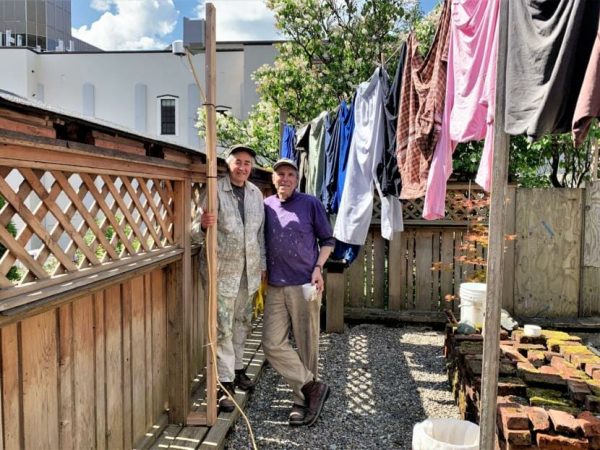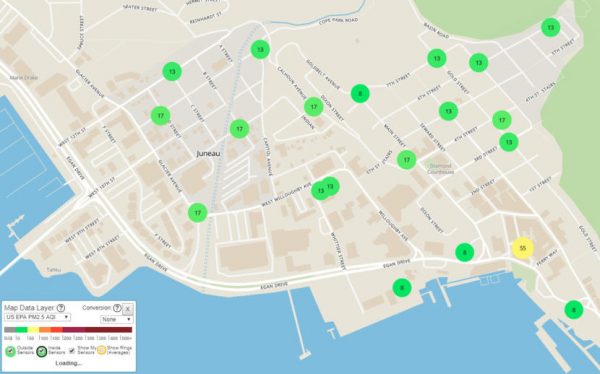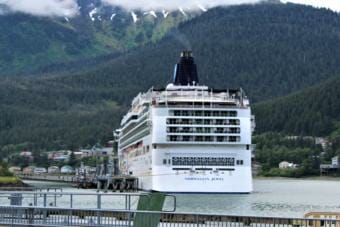
This summer, the Alaska Department of Environmental Conservation is conducting an air quality study in Juneau.
It’s the first study of its kind in Alaska, and the first comprehensive look at the impact of cruise ship emissions in Juneau in almost 20 years.
Underneath the chatter of tourists and the sound of floatplanes, helicopters and shuttle buses at Juneau’s cruise ship docks, you can just make out the low rumble of the ships’ engines.
On any day, you can see faint plumes of exhaust coming out of their stacks.
It’s those plumes — and what was in them — that used to fascinate Martha and Jim Stey’s good friend, Jon Sandstedt. Whenever Sandstedt would come over to their downtown home overlooking the harbor, he would look out on the cruise ships and the ribbons of blue exhaust rising above them.
“Jon said, ‘I’m going to do something about that.’ And so he got trained to be a visual inspector, and it’s a lot of training, you have to be able to look, to sense how much particles are in the air,” Jim Stey said.
Sandstedt did that for a few years before moving away.
He has since died, but the Steys still think of him whenever they see the plumes. When they heard the Department of Environmental Conservation was looking for volunteers to host electronic air monitors, they signed up.
“And so, this is Jon in our backyard here, hanging up there, measuring it,” Jim Stey said, gesturing to a small box fixed to the top of a wooden pole on their back fence.
From April through October, the Steys’ backyard will serve as a laboratory. The sensor at the top of the pole takes regular measurements of particulate matter in the air. Those measurements are added to a central database, along with the information recorded by 20 other sensors placed around downtown.
The volunteers supply power to run their sensors. In return, Martha Stey said she and Jim feel they’re doing their part to protect Juneau’s quality of life.
“We’re just hoping to learn what quality our air is, if there’s anything that we can do about it … that if there is a problem we can help affect changes,” Martha Stey said.
But you don’t have to be a volunteer to see what’s being tracked: Anyone can watch the sensors collecting data in real time online.
The DEC’s website links to a map where you can see a layout of downtown Juneau covered in dots. Each one shows you what the sensors are reading. It updates about every 80 seconds. The dots range from green to red, depending on what they’re picking up. Usually the dots show up green, but at various points during the day, you might notice one or two yellow, orange or even red dots, especially closer to the cruise ship docks.
But it’s not as easy as pointing to a big red dot over City Hall and blaming it on the nearby ships. The people conducting the study said there are many factors at play.

“If there’s a vehicle that drives by, you get some of that exhaust passing the sensor. And then the next minute it can be gone, and you can have cleaner air again,” said Barbara Trost, a program manager for DEC’s Division of Air Quality.
Trost is based in Anchorage, but her department is overseeing the study and regularly monitoring the data.
She said a lot has changed in the 20 years since the last air quality study was done in Juneau, including the number and size of ships visiting in the summer.
“So we’ve gotten a lot of complaints over the last couple of years from people in the downtown area about cruise ship emissions and the plumes that they can see and smell,” Trost said.
She said what they’re interested in seeing is whether those readings remain high for extended periods of time. That would indicate that heavy particulates in the air are sticking around, which could create problems.

Trost said the sensors don’t measure diesel fumes, which is the primary concern from cruise ship exhaust. What they do measure is the concentration of fine particulate matter over time.
“It’s basically a type of particle that can be inhaled deep into the lungs and has a potential for creating health impacts,” she said.
Trost said they may decide to do another study in the future to determine what exactly those particles are made of and where exactly they’re coming from.
The sensor the Steys have in their backyard right now is made by a company called PurpleAir, and it only costs about $250.
If DEC decides to do a more in-depth study later on, Trost said that will require sensor technology that can cost up to $10,000 to $20,000 each. She said they’re also doing a separate, smaller study this summer tracking sulphur dioxide, or SO2, which is a component of diesel fuel.
For Martha Stey, cruise ship emissions have never been a major concern. She thinks of them as more of a nuisance. But she recognizes that understanding them is important.
“Information is power,” she said. “We’re just gathering more information so we really know more about our environment.”
DEC plans to release a draft report on the PurpleAir study by next spring.
Trost said they may hold a public meeting to present the data and solicit comments.




